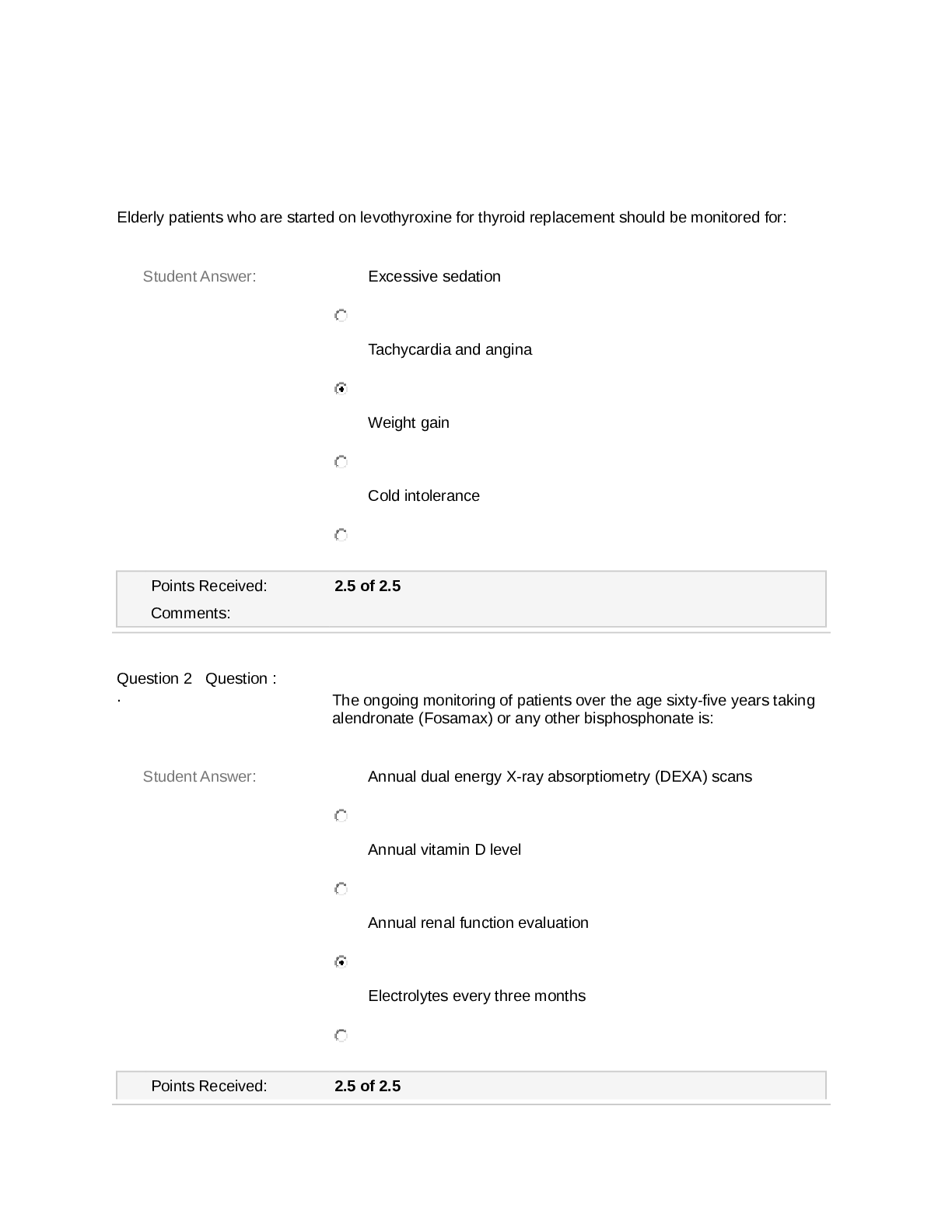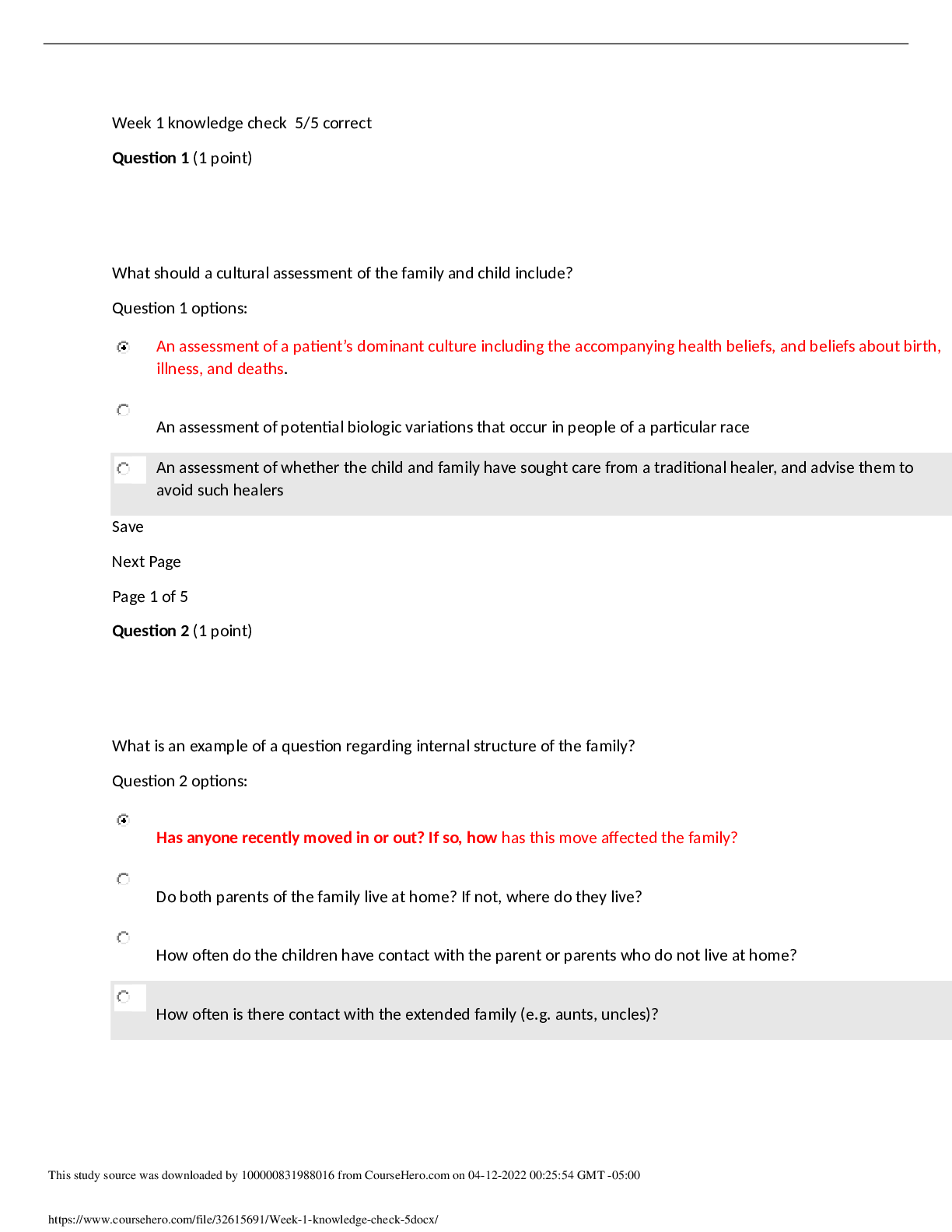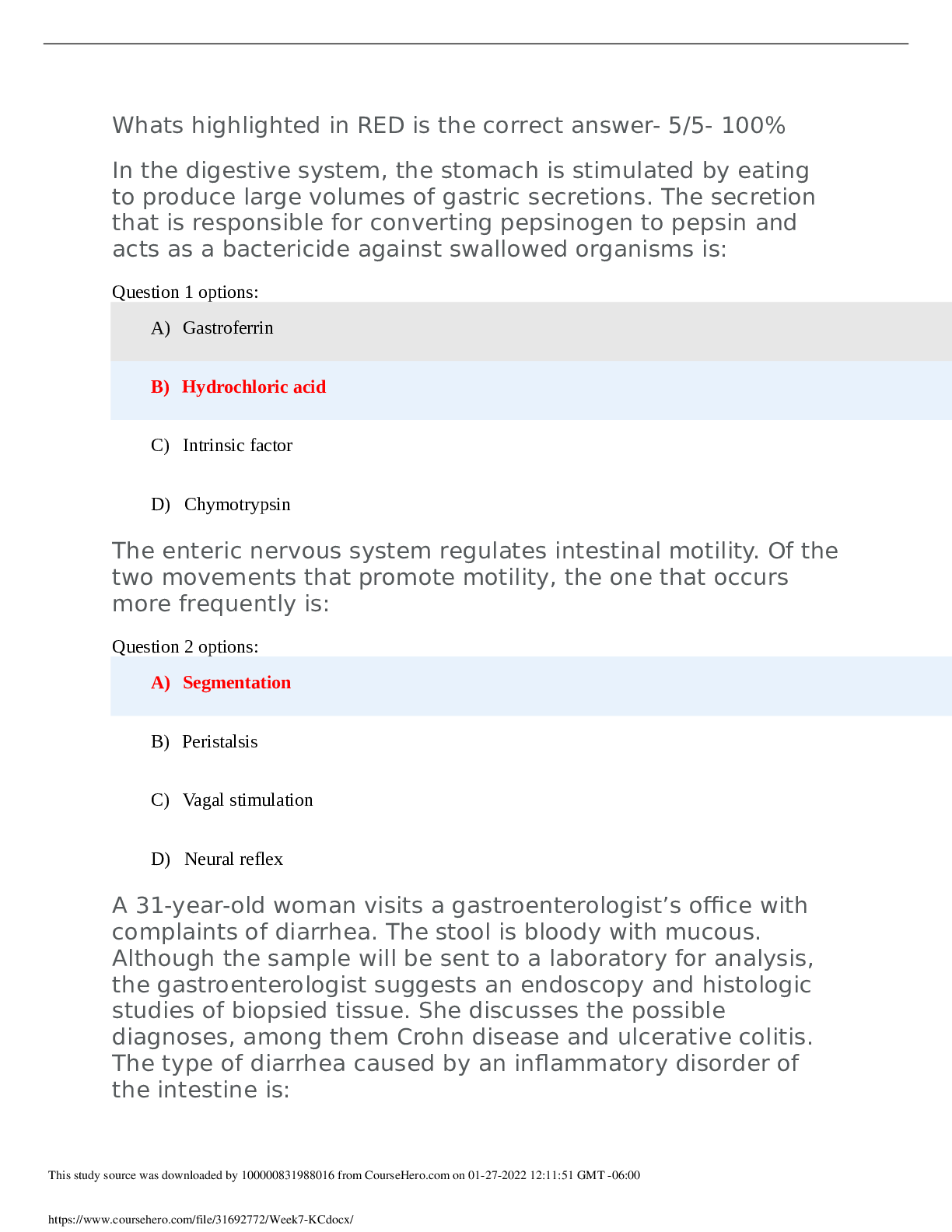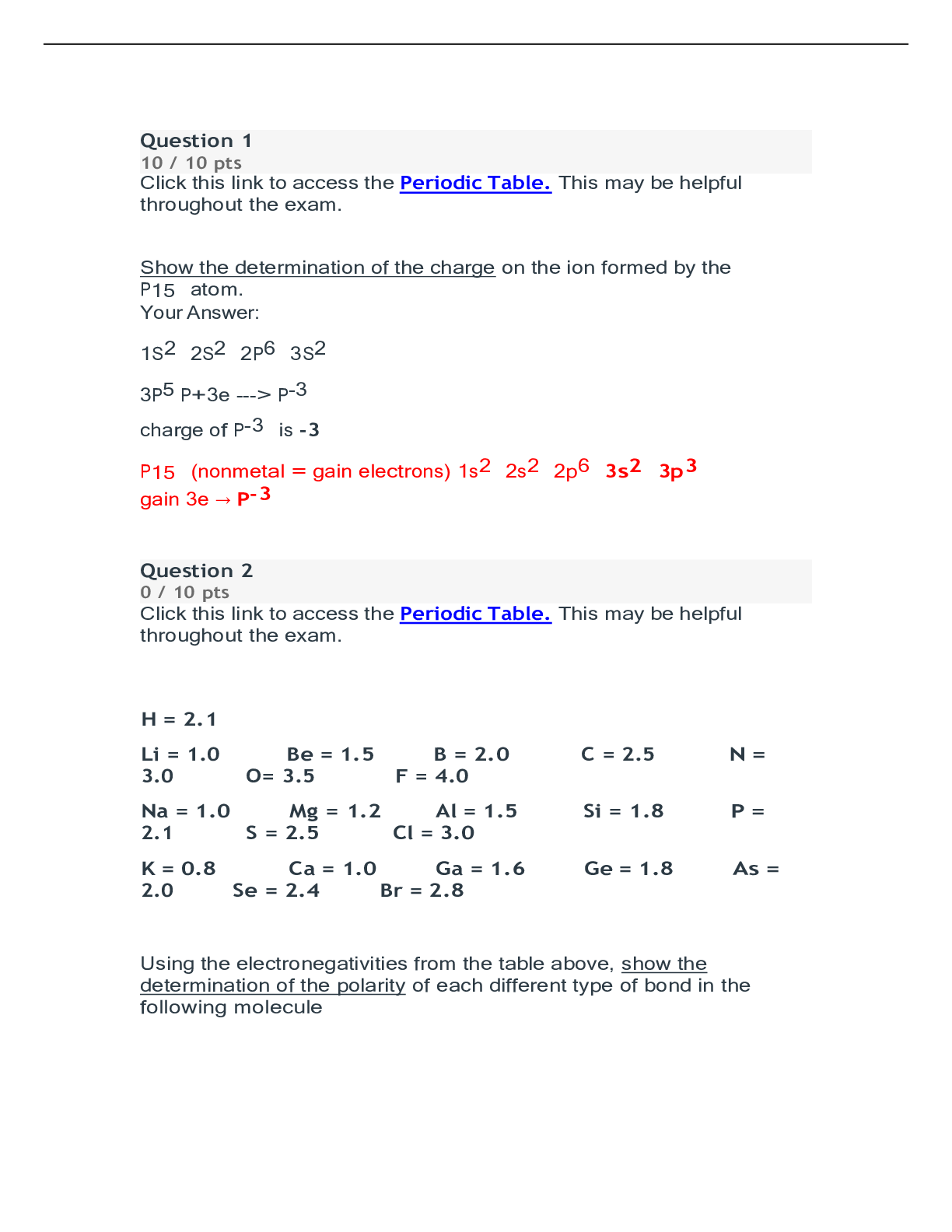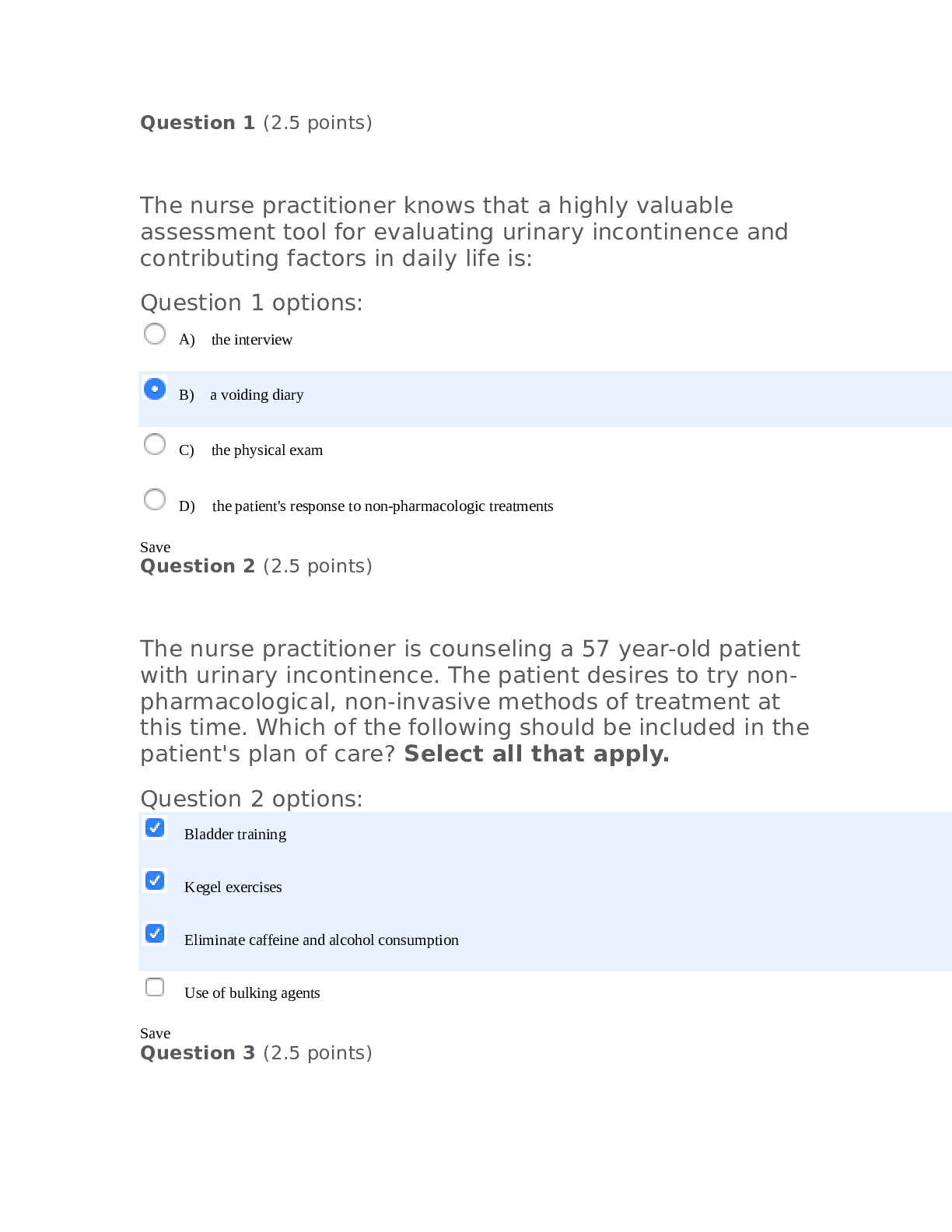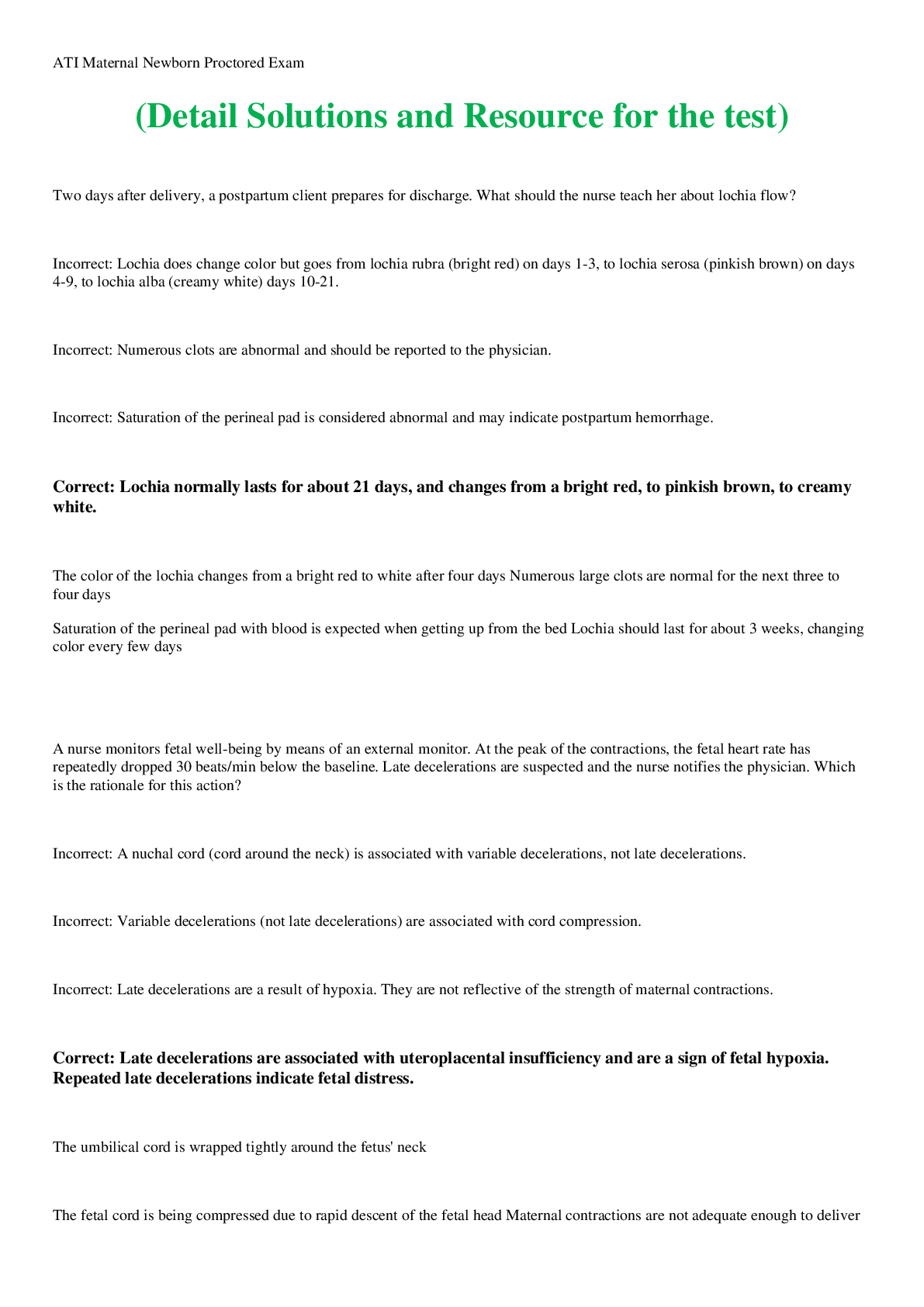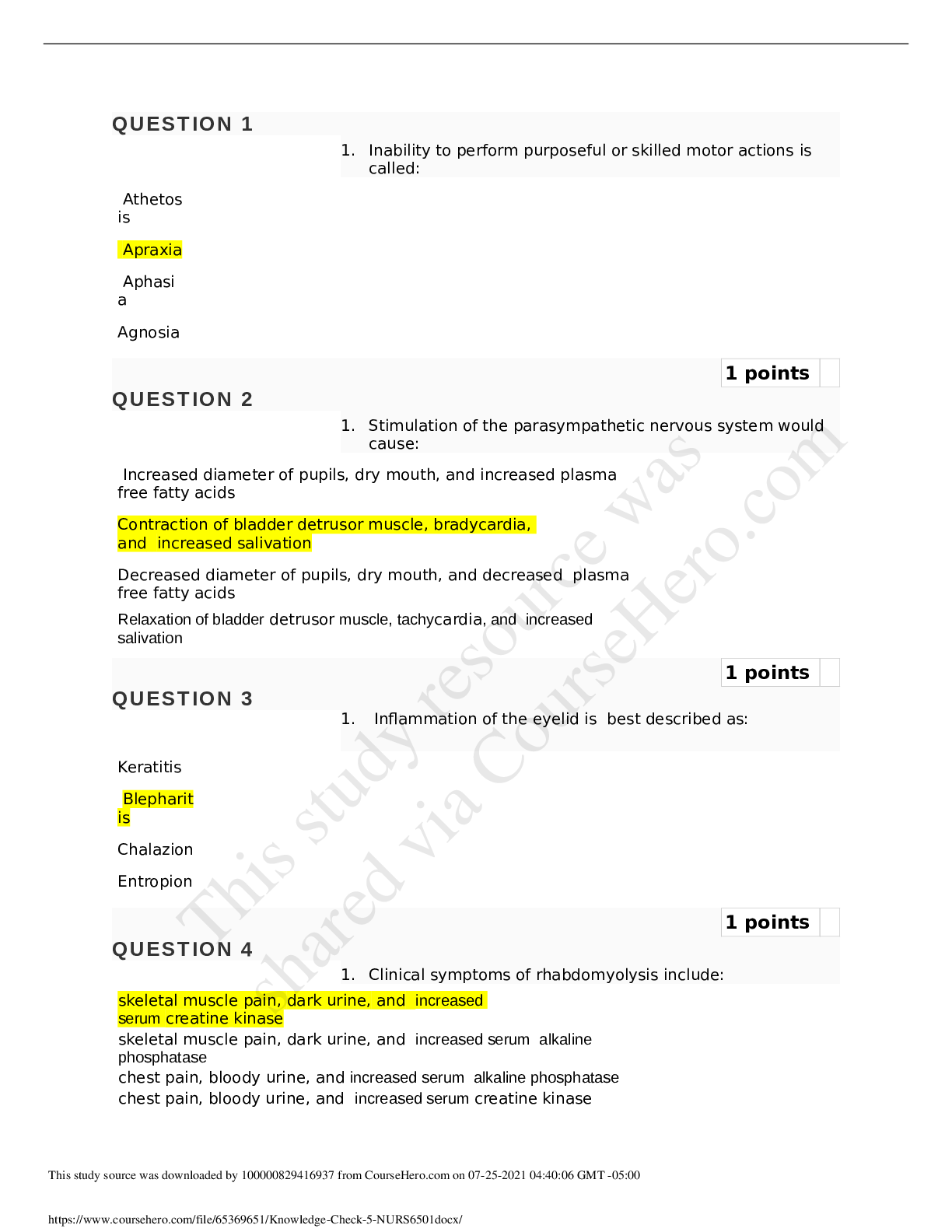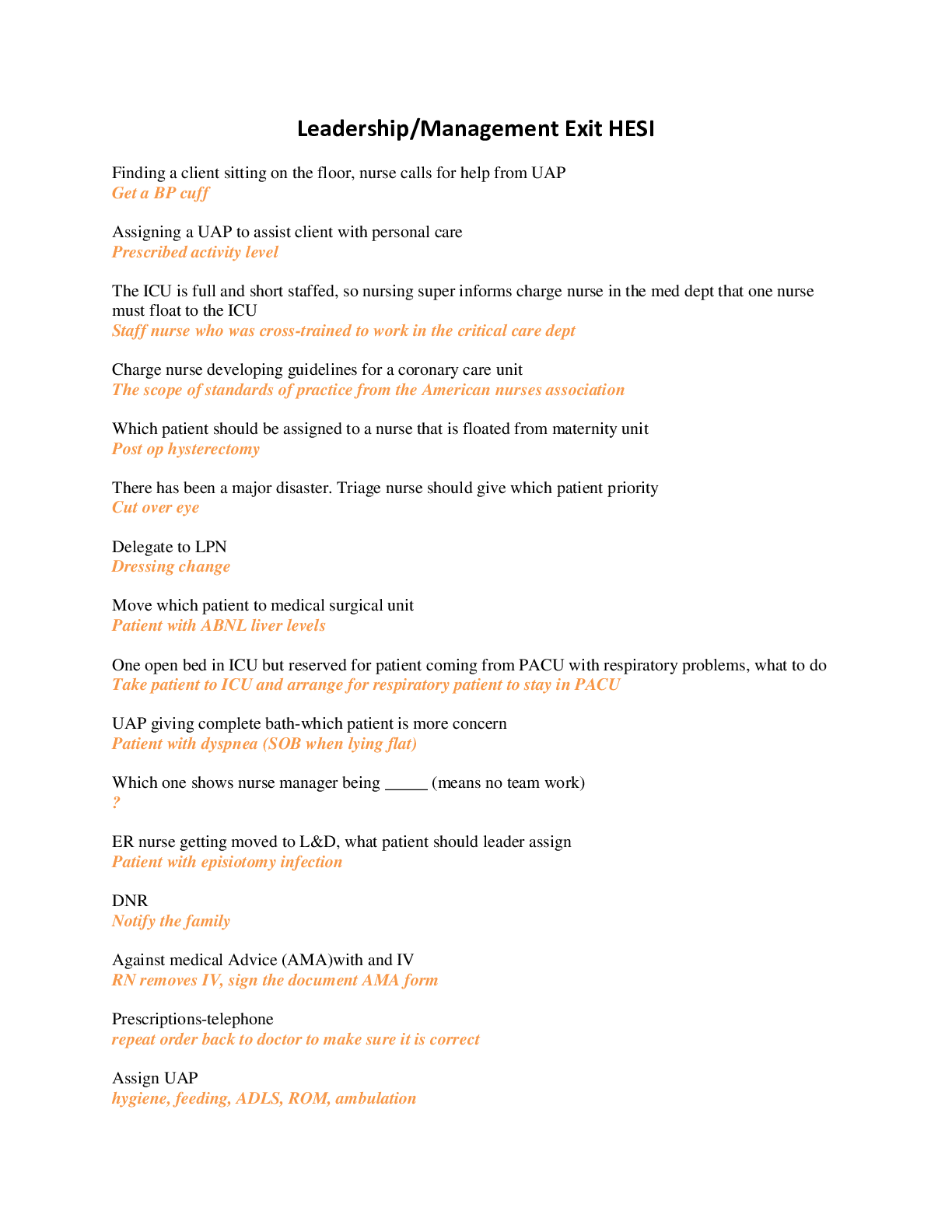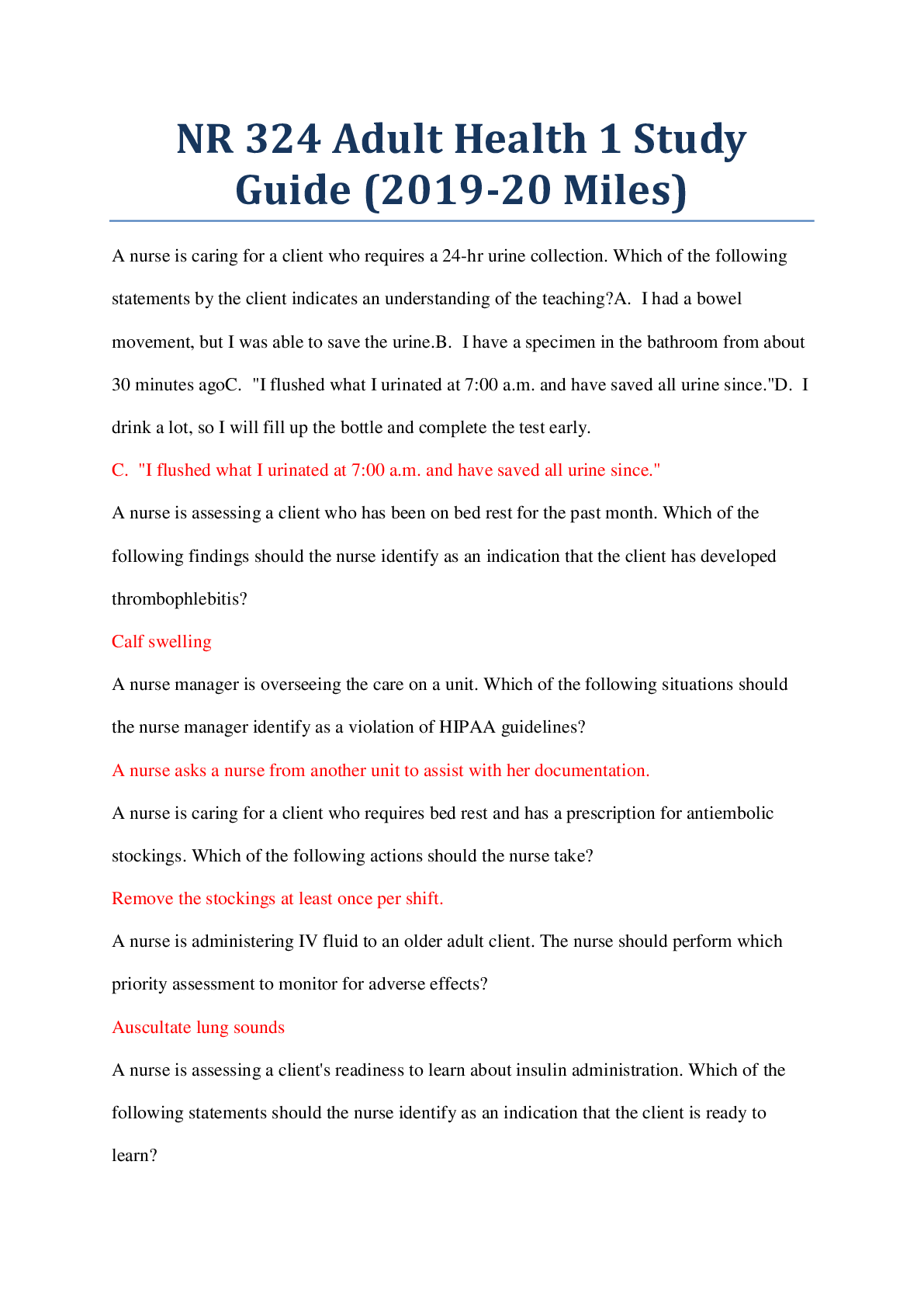*NURSING > QUESTIONS & ANSWERS > NSG6020 TEST BANK (MIDTERM EXAM+FINAL EXAM) / NSG 6020 TEST BANK (MIDTERM EXAM+FINAL EXAM) : GRADED (All)
NSG6020 TEST BANK (MIDTERM EXAM+FINAL EXAM) / NSG 6020 TEST BANK (MIDTERM EXAM+FINAL EXAM) : GRADED A | 100% CORRECT |SOUTH UNIVERSITY
Document Content and Description Below
10. Which of the following are examples of secondary prevention? (Choose all that apply) A. Hard hats, needle-free devices, sharps containers. B. Blood pressure screening at health fair. C. Control... of the spread of tuberculosis. D. Dental sealants on children's teeth. 1. Mrs. Brody has brought his 16-year-old daughter, Mandy, for a school sports physical exam. Mandy's height is 65 inches, and she weighs 126 lbs. Mrs. Brody is concerned that her daughter is overweight. According to Mandy's BMI, what is your response? A. Mandy is overweight and needs to take diet pills. B. Reassure the mother that this is a normal body weight. C. Refer the patient to a nutritionist and psychologist because the patient is anorexic. D. Give the patient information about exercise and reduction of fat cholesterol in her diet because she is overweight. B - (126 X 700) / (65^2) = 20.9 Body Mass Index (BMI) = (Weight (lbs) x 700)/(height (inches)^2) - Underweight: BMI < 18.5 - Normal: BMI 18.5-24.9 - Overweight: BMI 25.0-29.9 - Obesity I: BMI 30.0-34.9 - Obesity II: BMI 35.0-39.9 - Extreme Obesity III: BMI ≥ 40 1. A sudden painless unilateral vision loss may be caused by which of the following - Retinal detachment 2. A 73 year old nurse comes to your office for evaluation of new onset of tremors. She is not on any medications and does not take herbs or supplements. She has no chronic medical conditions. She does not smoke or drink alcohol. She walks into the examination room with slow movements and shuffling steps. She has decreased facial mobility and a blunt expression without any changes in hair distribution on her face. Based on this what is the most likely diagnosis. - Parkinsons 3. You are interviewing an elderly woman in the ambulatory setting and trying to get more information about her urinary symptoms. Which of the following techniques is not a component of adaptive questioning - Reassuring the patient that the urinary symptoms are benign and that she doesn’t need to worry about it being a sign of cancer. 4. A fifteen year old high school sophomore comes to the clinical for evaluation of a three week history of sneezing itchy watery eyes clear nasal discharge ear pain and non productive cough. Which is the most likely pathologic process? 5. a light is pointed at a patients pupli, which contracts it is also noted that the other pupil contracts as well, though it is not exposed to bright light. Which of the following terms describes this latter phenomenon - Consensual reaction. 6. Which of the following is used to screen for color blindness in a seven year old boy - Ishihara test 7. You feel a small mass that you think is a lymph node. It is mobile in both up and down and side by side direction. Which of the following is most likely 8. Lymph node 9. What is the best procedure for evaluating a corneal abrasion 10. Which of the following is a symptom involving the eye - Scotomas 11. Most sensitive test to detect hearing loss ? is it whisper or tuning forks 12. HA that has lasted 5 days and he does work at a computer is it a cluster, migraine, tension headache 13. A 55 year old bank teller comes to your office for persistent episodes of dizziness. The first episode started suddenly and lasted 3-4 hours. He experienced a lot of nausea with vomiting. The episode resolved spontaneously. He has had five episodes in the past 1 ½ weeks. He does note some tinnitus that comes and goes. upon physical exam you note that he has a normal gait. The weber localized to the right side and the air conduction is equal to the bone conduction in the right ear. Nystagmus is present. Based on this description what is the most likely diagnosis - Meniere’s disease - - A 35-year-old archaeologist comes to your office (located in Phoenix, Arizona) for a regular skin check-up. She has just returned from her annual dig site in Greece. She has fair skin and reddish-blonde hair. She has a family history of melanoma. She has many freckles scattered across her skin. From this description, which of the following is not a risk factor for melanoma in this patient? A) Age B) Hair color C) Actinic lentigines D) Heavy sun exposure - answer- A - A 15-year-old high school sophomore and her mother come to your clinic because the mother is concerned about her daughter's weight. You measure her daughter's height and weight and obtain a BMI of 19.5 kg/m2. Based on this information, which of the following is appropriate? A) Refer the patient to a nutritionist and a psychologist because the patient is anorexic. B) Reassure the mother that this is a normal body weight. C) Give the patient information about exercise because the patient is obese. D) Give the patient information concerning reduction of fat and cholesterol in her diet because she is obese. - answer- B - A 32-year-old attorney comes to your office for her second prenatal visit. She has had two previous pregnancies with uneventful prenatal care and vaginal deliveries. Her only problem was that with each pregnancy she gained 50 lbs (23 kg) and had difficulty losing the weight afterward. She has no complaints today. Looking at her chart, you see she is currently 10 weeks pregnant and that her prenatal weight was 130 lbs (59 kg). Her weight today is 134 lbs (60.9 kg). Her height is 5'4", giving her a BMI of 22. Her blood pressure, pulse, and urine tests are unremarkable. The fetal heart tone is difficult to find but is located and is 150. While you give her first trimester education, you tell her how much weight you expect her to gain. How much weight should this patient gain during pregnancy? A) Less than 15 pounds (less than 7 kg) B) 15 to 25 pounds (7 to 11.5 kg) C) 25 to 35 pounds (11.5 to 16 kg) D) 30 to 40 pounds (12.5 to 18 kg) - answer- C - Nice work! - You just studied 158 terms! - Now up your study game with Learn mode. - Try Learn modeStudy with Flashcards again - 3/158 - Created by - f94248 - Study Guide-Flashcards - Terms in this set (158) - - A 22-year-old advertising copywriter presents for evaluation of joint pain. The pain is new, located in the wrists and fingers bilaterally, with some subjective fever. The patient denies a rash; she also denies recent travel or camping activities. She has a family history significant for rheumatoid arthritis. Based on this information, which of the following pathologic processes would be the most correct? A) Infectious B) Inflammatory C) Hematologic D) Traumatic - answer- B - A 35-year-old archaeologist comes to your office (located in Phoenix, Arizona) for a regular skin check-up. She has just returned from her annual dig site in Greece. She has fair skin and reddish-blonde hair. She has a family history of melanoma. She has many freckles scattered across her skin. From this description, which of the following is not a risk factor for Original melanoma in this patient? A) Age B) Hair color C) Actinic lentigines D) Heavy sun exposure - answer- A - A 15-year-old high school sophomore and her mother come to your clinic because the mother is concerned about her daughter's weight. You measure her daughter's height and weight and obtain a BMI of 19.5 kg/m2. Based on this information, which of the following is appropriate? A) Refer the patient to a nutritionist and a psychologist because the patient is anorexic. B) Reassure the mother that this is a normal body weight. C) Give the patient information about exercise because the patient is obese. D) Give the patient information concerning reduction of fat and cholesterol in her diet because she is obese. - answer- B - A 32-year-old attorney comes to your office for her second prenatal visit. She has had two previous pregnancies with uneventful prenatal care and vaginal deliveries. Her only problem was that with each pregnancy she gained 50 lbs (23 kg) and had difficulty losing the weight afterward. She has no complaints today. Looking at her chart, you see she is currently 10 weeks pregnant and that her prenatal weight was 130 lbs (59 kg). Her weight today is 134 lbs (60.9 kg). Her height is 5'4", giving her a BMI of 22. Her blood pressure, pulse, and urine tests are unremarkable. The fetal heart tone is difficult to find but is located and is 150. While you give her first trimester education, you tell her how much weight you expect her to gain. How much weight should this patient gain during pregnancy? A) Less than 15 pounds (less than 7 kg) B) 15 to 25 pounds (7 to 11.5 kg) C) 25 to 35 pounds (11.5 to 16 kg) D) 30 to 40 pounds (12.5 to 18 kg) - answer- C - You are beginning the examination of the skin on a 25-year-old teacher. You have previously elicited that she came to the office for evaluation of fatigue, weight gain, and hair loss. You strongly suspect that she has hypothyroidism. What is the expected moisture and texture of the skin of a patient with hypothyroidism? A) Moist and smooth B) Moist and rough C) Dry and smooth D) Dry and rough [Show More]
Last updated: 1 year ago
Preview 1 out of 122 pages
Instant download
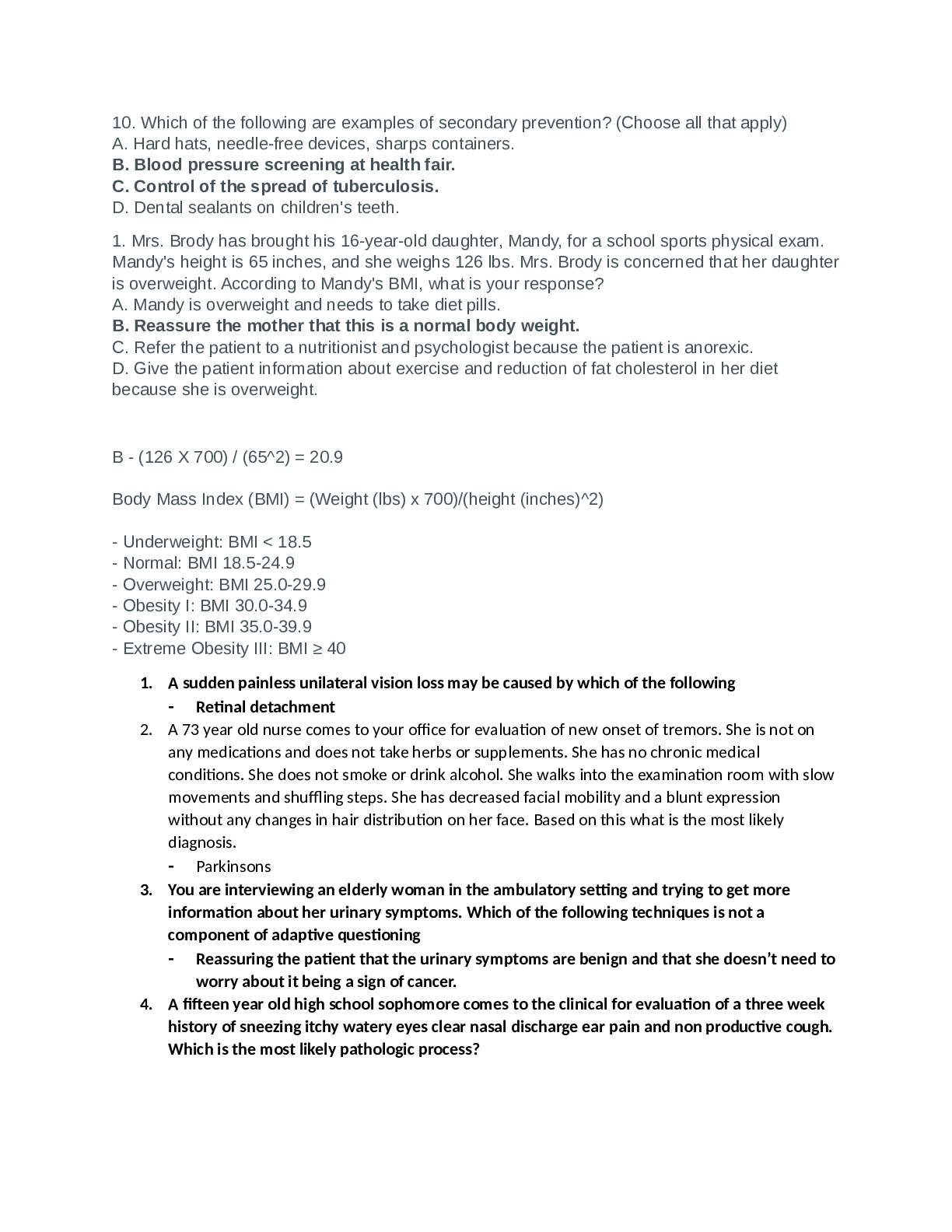
Instant download
Reviews( 0 )
Document information
Connected school, study & course
About the document
Uploaded On
Jan 26, 2022
Number of pages
122
Written in
Additional information
This document has been written for:
Uploaded
Jan 26, 2022
Downloads
0
Views
100

.png)
.png)
.png)
.png)
.png)
.png)
.png)
.png)
.png)
.png)
.png)

.png)
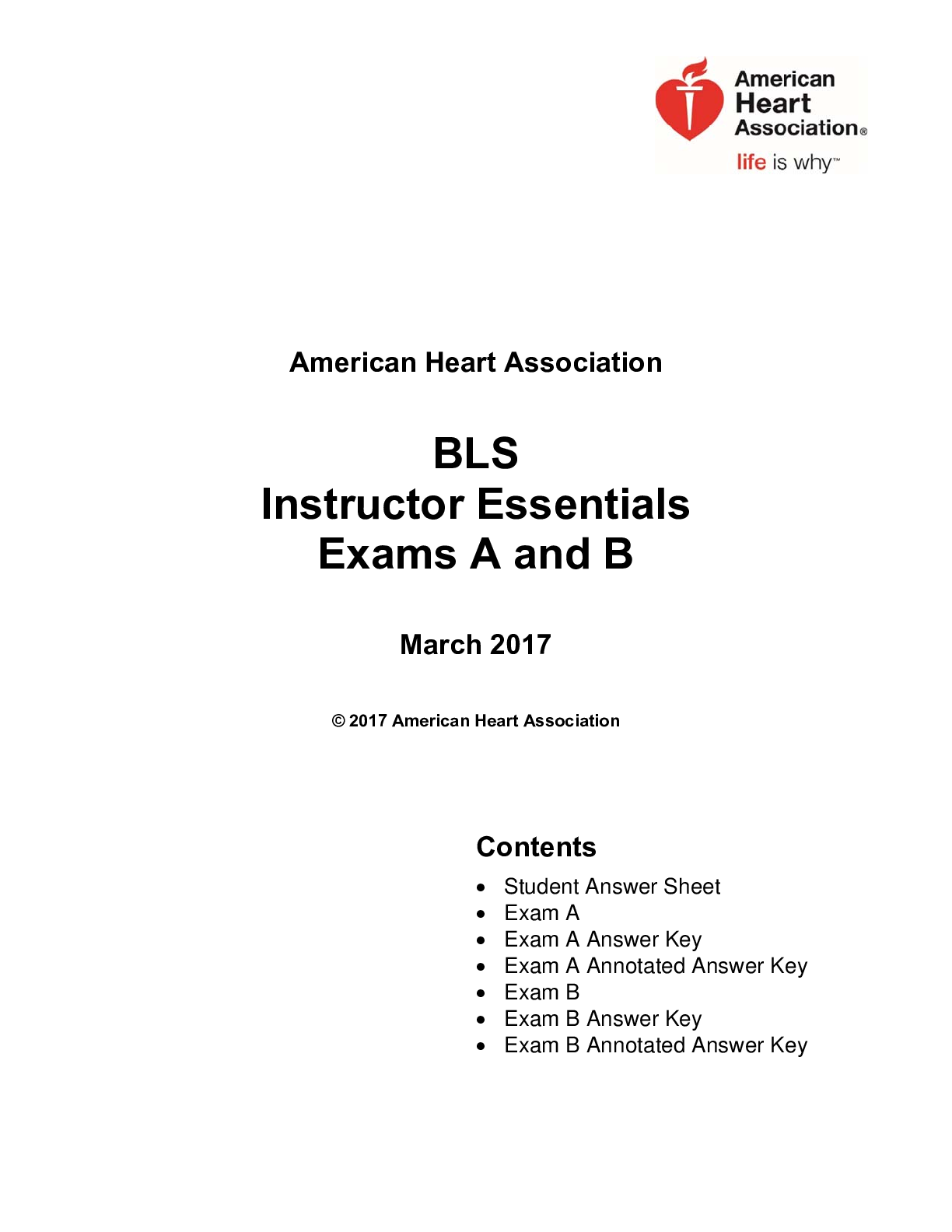
.png)
.png)
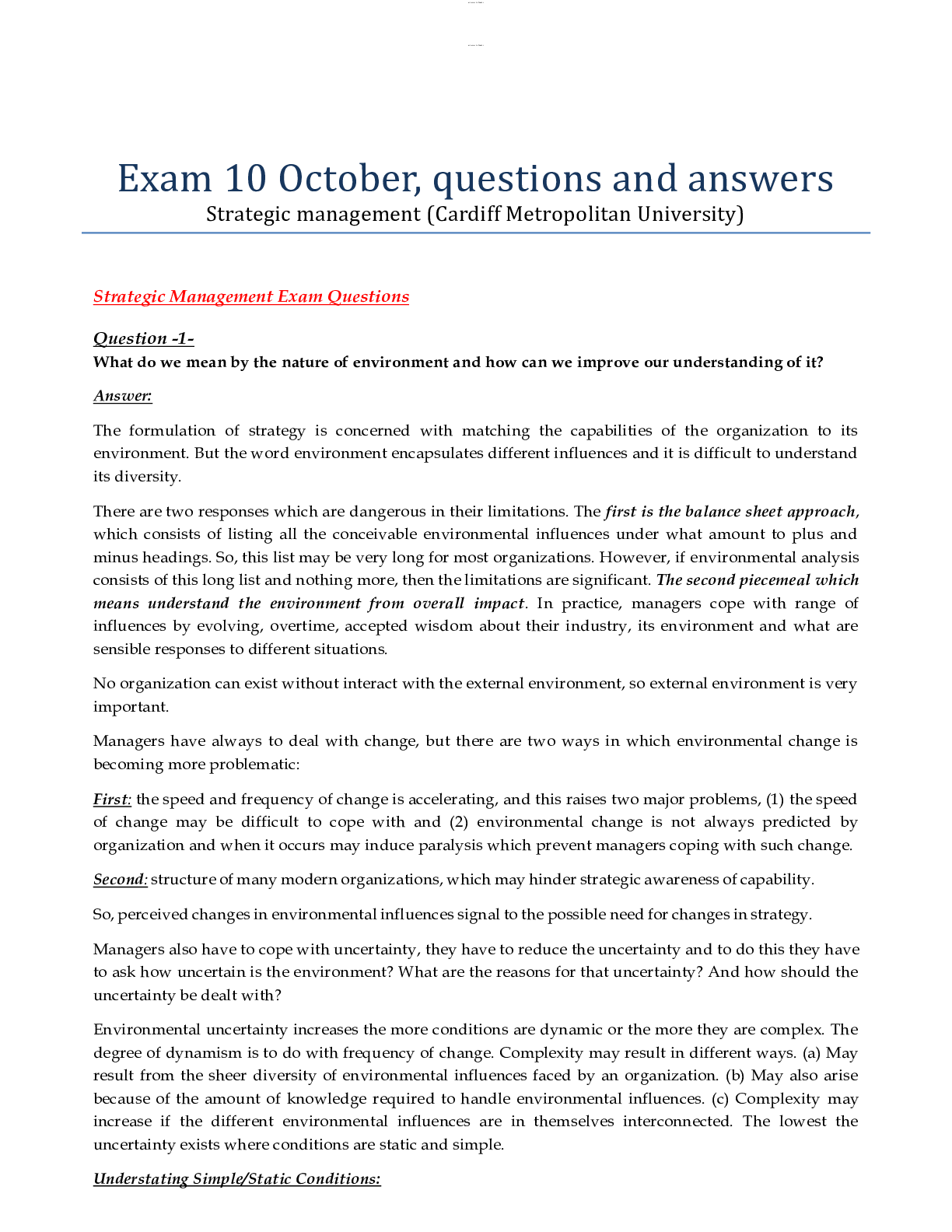
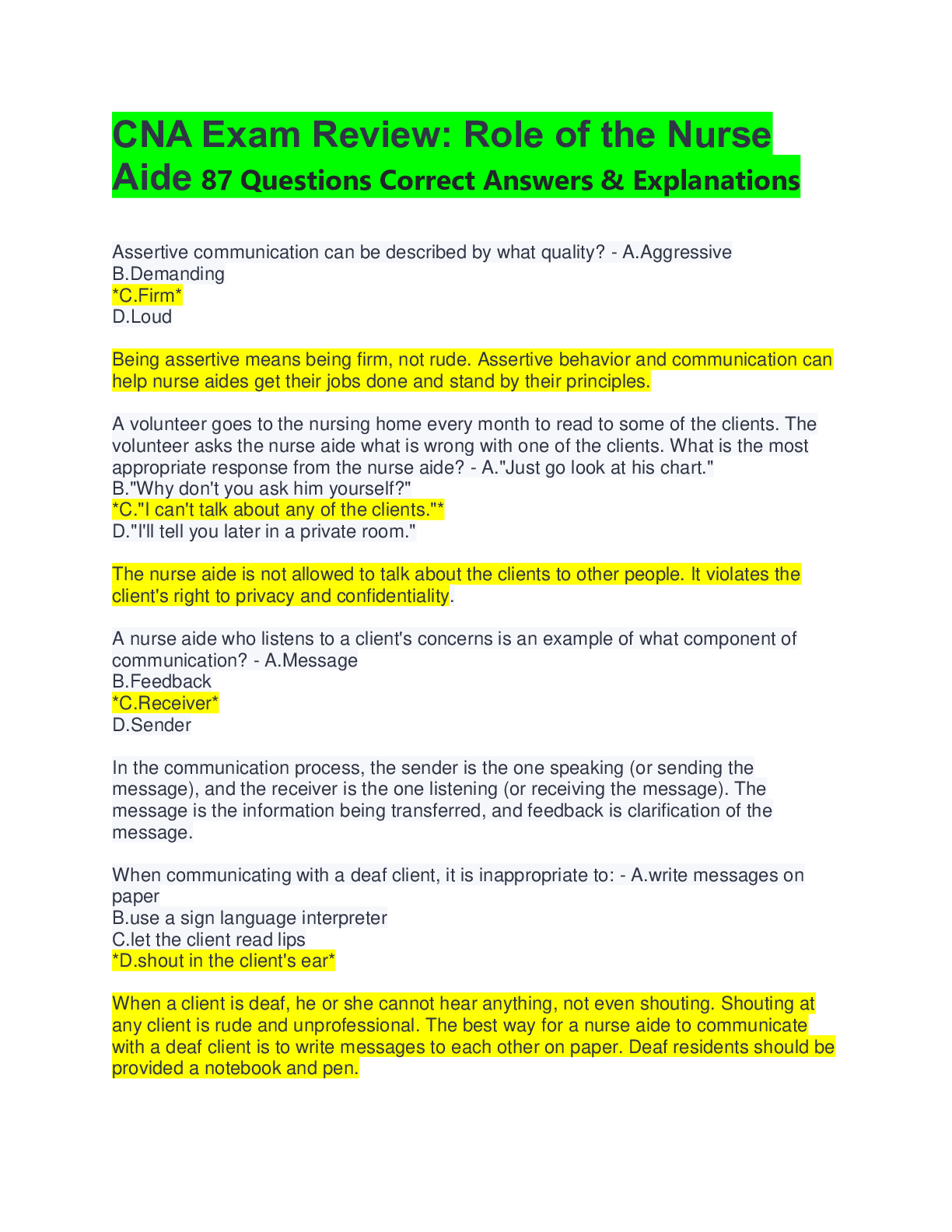

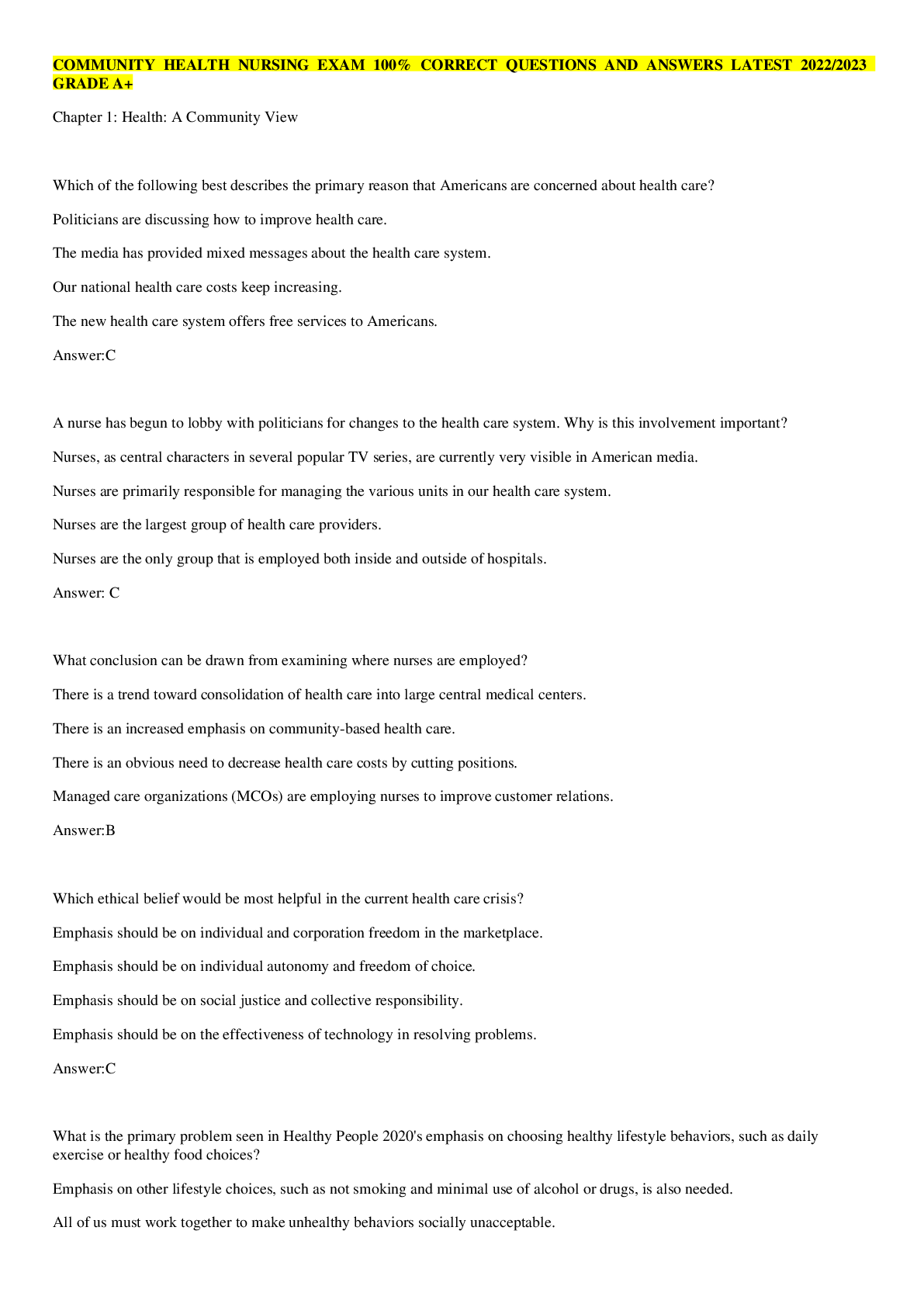
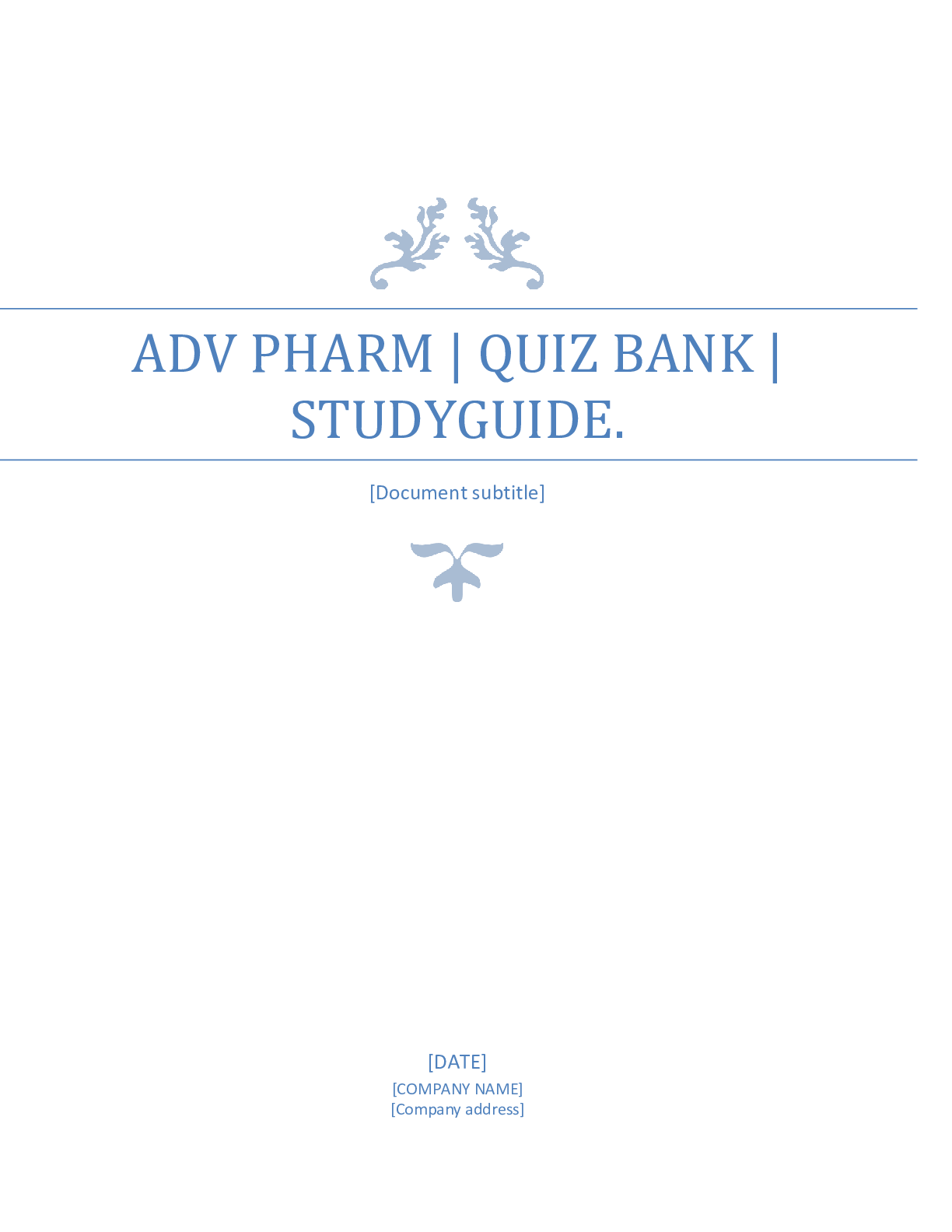
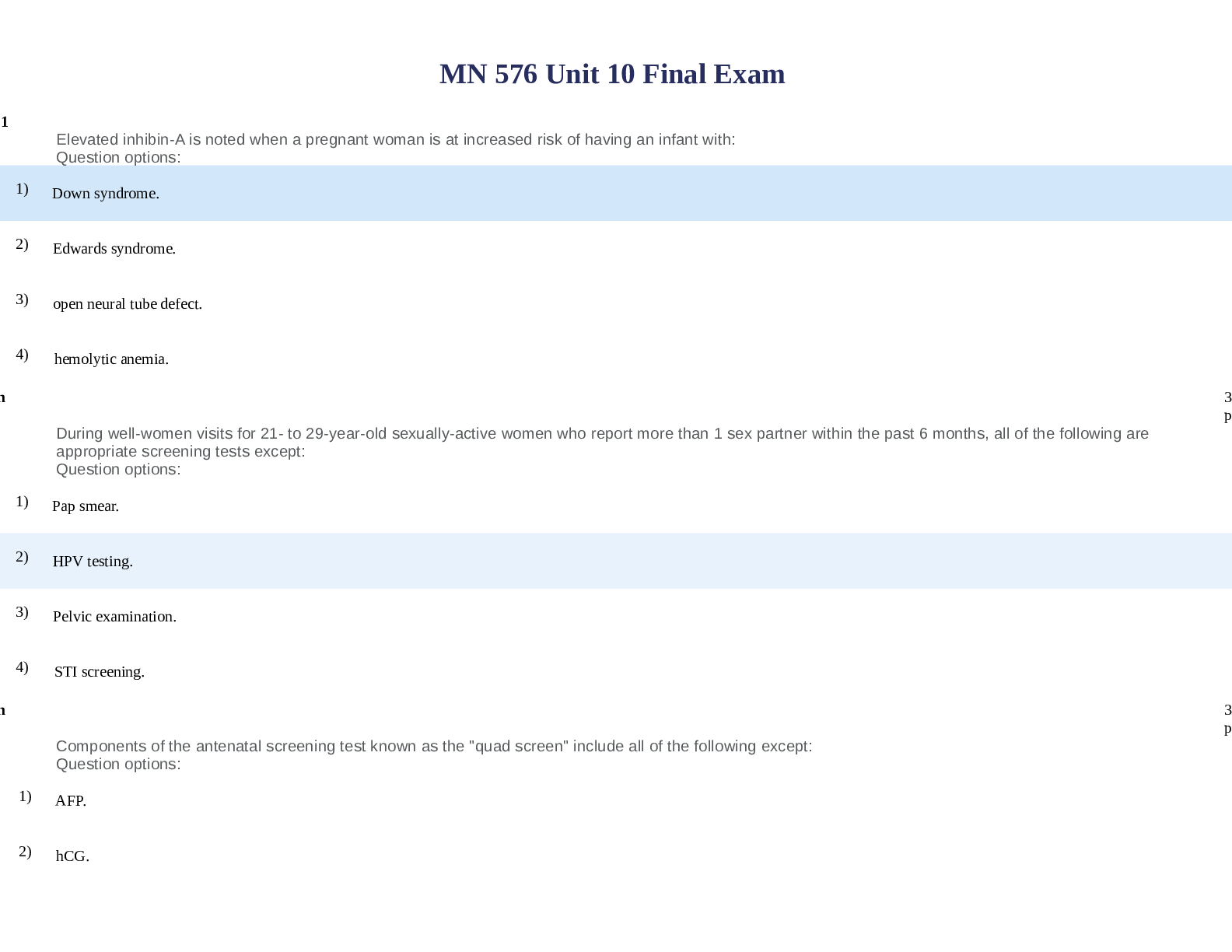
.png)
